Appendix A2 The Evidence Based Practice Question Development & Search Checklist
Phase One:
Problem/Issue: What problem are you addressing?
Why is this a problem? What data/measures or evidence/practice observations could be used to show this is a problem? (Internal evidence) What is it affecting? Why do we care? What might happen if we did nothing to change it?
Describe current practice related to your problem. Ex: Key observations, processes in place such as audits, EMR documentation, etc., relevant to the problem.
Is there already an established way of addressing this problem that is based on evidence?
| Talked with a nurse manager, nurse clinician, nurse educator, or director. | Checked for available hospital and/or unit procedures/policies/protocols. | ||
| Talked with a hospital or subject matter expert. | Checked for practice guidelines.
|
||
Checked for existing evidence in systematic reviews or meta-analyses.
|
Identify potential project stakeholders. You may need to talk with these people or departments for insight or to find evidence. These same contacts may be future networks or you. It is recommended to document who you spoke to, when, the topic discussed, and what was learned.
Consider the appropriateness of the clinical question. Things to consider when it comes to the potential project if it were to be implemented. These questions need to be identified to ensure success for potential implementation.
| Is the problem/issue/topic within the scope of nursing practice? | |
| What hospital patient safety goal or initiative does the problem align with, if any? (Look up the hospital/organization’s goals and/or initiatives, talk with hospital manager, etc.) | |
| How much time do you think would be needed to implement the project? Be specific. (ex: If semester ends on first week of May, what would be the future dates for gathering a team, development of action plans, and then implementation.) | |
| Resources? Does the organization have the tests, equipment, and other resources that will be needed for this intervention to be implemented? (Remember, it will not be implemented but it is best to find out if it could reasonably be done.) | |
| Cost/Return of Investment (ROI). What would you expect the costs of the practice chance to be as well as what are the potential cost savings for the organization? Talk to your organization’s connection. They can help give you an idea. A general guestimate is fine. | |
| Team Identified. Have you identified individuals to assist you with this project? Be sure to get an informal commitment that those identified would be willing to assist, as this may be a project you could implement later in your nursing program or in graduate school. |
Phase Two:
Constructing Your Clinical Question
Start with a background question (broad) and move towards a foreground question (focused – PICO format).
Background Question
Provides general information that enables one to gain a greater understanding and allows one to understand the options or possibilities when it comes to addressing a topic Tend to have two components: A question root (who, what, when, etc.) with a verb followed by a disorder, test, treatment, etc.
Question Template for Asking Your PICO Question
Intervention
In __________________(P), how does _______________(I) compared to ______________(C) affect _______________(O)?
Etiology
Are _________________(P), who have _______________(I) compared with those without ______________(C) at risk for/of _______________(O)?
Diagnosis or Diagnostic Test
In __________________(P) are/is ________________(I) compared to _____________(C) more accurate in diagnosing ______________(O)?
Prognosis/Prediction
In (For) ________________(P), how does _______________(I) compared to _____________(C) influence _______________(O)?
Meaning
How do ________________(P) with _____________(I) perceive _____________(O)?
Melnyk, B. M., & Fineout-Overholt, E. (2011). Evidence-based practice in nursing & healthcare: A guide to best practice. Philadelphia: Wolters Kluwer/Lippincott Williams & Wilkins
Foreground Question – The Clinical Question
A focused question that asks something specific in order to make an informed clinical decision or action. Should not be directional.
Phase Three:
Searching the Literature (External Evidence)
|
P (Problem, Patient, Population, Program) |
I
(Intervention) |
C
(Comparison) What You are Doing Now or Alternative |
O
(Outcome) |
|
|
The Type of Question can Determine Type of Studies Needed.
However, for our EBP Project, since we are sticking with an Intervention/Therapy question, this limits us to mostly the top row for the best evidence to answer our question. Don’t forget, though – you are allowed to use only one secondary study for your EBP Project. Some types of articles you will find can include experimental, non-experimental, quasi-experimental, retrospective, and correlational designs. Those would all be absolutely appropriate.
| Type of Question | Best Type of Evidence / Study |
| Intervention/Therapy: How well do interventions or treatments work in respect to an outcome. May address harm, viability, or cost. | Randomized Control Trial (RCT), Blind RCT, Cohort Study, Systematic Review, Meta-Analysis of RCTs |
| Prevention: How to prevent a disease or condition | RCT/ Cohort Study / Case Control / Systematic Review, Meta-Analysis |
| Prognosis / Prediction: How to estimate the patient’s likely clinical course over time and anticipate the likely complications of the disease or condition. | Cohort Study / Case Control / Case Series or Case Report / Synthesis or Cohort or Case Control Studies / Meta- Synthesis |
| Diagnosis or Diagnostic Test: How to select what mechanism or diagnostic tests to most accurately determine outcome. | Blind RCT Compared to Gold Standard (Best Treatment or Test) / Systematic Review / Meta-Analysis of RCTs |
| Etiology: Identify factor, process, condition that is associated or correlated with an outcome or disease. | RCT / Cohort Study / Case Control / Meta-Synthesis |
| Meaning: How an experience influences an outcome, the phenomena or health care. | Meta-Synthesis / Qualitative Studies |
| Cost Analysis: Economic costs of all facets of a intervention or disease treatment. | Economic Analysis. |
Next, let’s break down the PICO and develop some search strategies.
Search Terms/Concepts:
| PICO Components | Primary Search Terms | Alternative Terms |
| P |
|
|
| I |
|
|
| C |
|
|
| O |
|
Possible Limiters:
Gender:
Male___ Female___
Age Groups:
All Ages___
Newborn (<1 month)___
Infant (1-23 months) ___
Adolescent (13-18)___
Adult (19-44) ___
Middle-Aged (45-64) ___
Elderly (65-79) ___
Aged (80+) ___
Languages:
English Only ___
Other Languages ___
Year of Publication:
0-5 years ___
5-10 years___
10-20 years___
20+ years___
Any known authors or researchers in the field? _____________________
Citations found that are related to the topic?
Appraisal of the Evidence Found – Is there enough?
Appraising the evidence when it comes to EBP ideally, should be done as team with more than one person appraising each article or piece of evidence. Lucky for you, you have a group to work with! Each person has a unique perspective based on their knowledge and experience, which may result in varying strengths regarding evidence appraisal.
- Start gathering evidence – don’t put this off!
- Fill out the Literature Synthesis Worksheet as you proceed
- Keep track of your search strategies
- Assess translation of evidence into potential practice setting
- Disseminate – Poster Presentation
Here we go! Let’s look for articles.
Break search into concepts:
- Easier to manipulate your search to get desired results.
- Start with two most important concepts from your question.
- Combine with Boolean operators – AND, OR, NOT

Come up with alternative terms or concepts for your topic:
- Different databases = different audiences
- Terms from related articles
- Google Scholar – just as a starting point, but it helps to search quickly for alternative terms/concepts
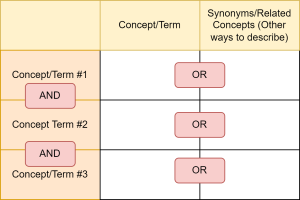
| Finding Too Many Articles? Ways to Decrease/Focus Your Results |
Not Finding Enough? Ways to Expand/ Increase Your Results |
|
|
Start your search broad and then focus.
Always search at LEAST two databases – Unique articles in each database.
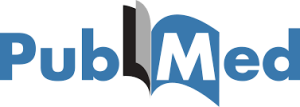 |
PubMed: Contains biomedical literature. Good place to search when the question is medical in nature or when you are not sure where to start. |
 |
Embase: Contains biomedical and pharmacological literature. Good place to search when it comes to medical, pharmacology and toxicology topics or questions. |
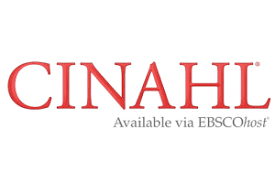 |
CINAHL (Cumulative Index of Nursing and Allied Health): Contains nursing and allied health literature. Good place to search when questions fall within the scope of nursing and allied health practice. |
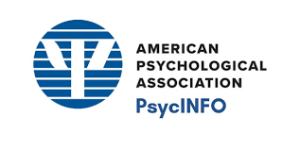 |
PsycInfo: Contains psychological literature. Good to search when the question addresses psychology or psychiatry topics. |
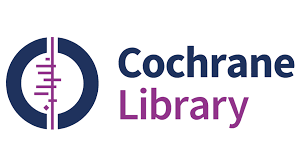 |
Cochrane Library: Resource that contains several different databases, one of those being the database of systematic reviews. Good place to search when searching for systematic reviews, economic evaluations and randomized controlled trials. |
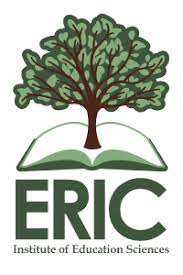 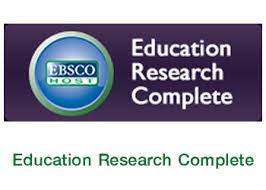 |
Education Resource Information Center or Education Research Complete: Contain educational research. Good places to search when your question addresses educational topics. |
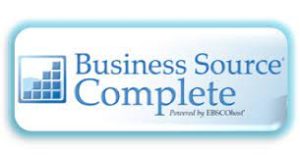  |
Business Source Complete or ABI/Inform: Contain business, management and economic research. Good places to search when your search address management, economic or business topics. |
 |
Academic Search Complete: Contains publications covering social science, education, psychology, and other subjects. Contains academic journals, magazines, and publication formats. A good place to search for general topics on an assortment of subjects. |
 |
Web of Science: Contains information about the basic sciences, social sciences, the arts and humanities. Contains journal articles, reviews, meeting/conference abstracts, books chapters and other types of publications. |
 |
Google Scholar: Indexes the full text of scholarly literature across an array of publishing formats like journal articles, theses, and preprints from various disciplines. The publications come from: Selected Academic Publishers Selected Professional Society Publishers Preprint Repositories Universities / University Repositories Scholarly Articles Available Across the Open Web / Open Access ArticlesShould never be sole resource searched. Good place to start to get an idea of what may be out there on a topic and identify some potential useful articles. Always Best to Use a Discipline Specific Database (PubMed, CINAHL, etc.) |
| Advantages | Disadvantages |
| Easy to Use: Interface similar to Google and can provide many relevant articles
Find Related Articles: “Cited By” feature allows one to find a list of related articles in Google Scholar that have cited the identified article. Strongest in Science & Technology Articles: This is a result of pulling citations from or partnerships with: PubMed: Patents and Legal Documents: Can find patents and legal documents but is not exhaustive for either. Citation Format: Can click on ( ) under the title of the article to get citations in MLA, APA, or Chicago style. |
Not Able to Search Comprehensively: Resource lacks the ability to easily focus your search. Can only limit by date with no ability to limit by publication type, language, sex or other useful filters found in discipline specific databases.
Current Articles Don’t Always Appear First: The resource uses an algorithm that considers relevancy, recency and citation counts when returning search results. This results in the most recent articles not being displayed first. Can be addressed some by limiting by year. Does not Define Scholarly Sources: Google does not release the parameters considered when a source is determined to be scholarly or not. Individual evaluation of sources found will be key. No Alert When Changes are Made: When changes are made to the resource there is no alert or information as to what resources or features have been added or taken away. This prevents one from being able to replicate searches over time.
|
(Logos used under fair use.)
Reasons for Differences in Searches:
| Word Choice | Background, education, perspective, profession |
| How Terms are Combined | Boolean Operators – AND/OR/NOT
|
| Databases Searched | PubMed/Medline or Ovid Medline
CINAHL
|
Different Word or Term Options:
| Use of quotation marks = Exact Phrase Searching |
|
Singular or Plural nurses vs. nurse |
|
Truncation (*) Nurs* = nurse, nurses, nursing |
|
Use of Limiters Put on after combining terms |
|
Field of Citation Searched Title, Abstract, etc. |
|
Compound Words Together or separate |

